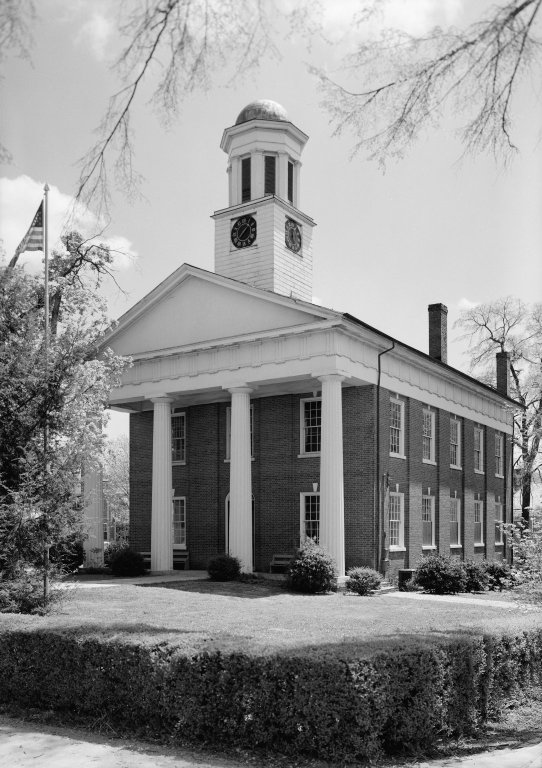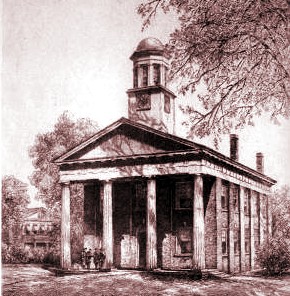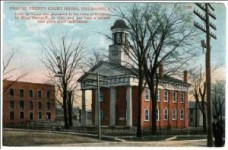Orange County Courthouses
There have been four courthouses in Hillsboro. The first was ready for use in December 1756. Prior to that date the County court held its sessions at the home of James Watson. In 1778 the legislature authorized the building of a district courthouse, on the site of the first courthouse. Citizens of Orange, Granville, Wake, Chatham and Caswell counties paid taxes “to take care of the building costs.” Nathaniel Rochester, who later founded a New York town by that name, and William Courtney announced in the North Carolina Gazette, June 26, 1778, that a contract would be let for a brick building; however, a frame building may have been erected. After the district courthouse was destroyed by fire, either late in 1789 or early 1790, the County court used a room at the home of John Taylor. The building of a third courthouse, second district courthouse, was authorized by the legislature in 1790. That body in 1799 permitted the County court to levy any tax that it deemed necessary for improvements on public buildings, provided the annual rate did not exceed six pence on each poll, two pence on every hundred acres of land, and six pence on every hundred pounds value of town property.
On September 7, 1844, the corner stone was laid for a fourth courthouse, a building which has now been used for more than a century. Members of the County court had talked about a new courthouse for almost twenty years. It was propaganda for the establishment of Alamance county that postponed the new building. Carrying out instructions from the County court, the new courthouse was built near the center of the public square in Hillsboro. Its cost was not to exceed eight thousand dollars, a sum which was to be paid within four years. According to the County court minutes of February, 1844, the building committee consisted of Harrison Parker, Edwin Holt, Dr. O. F. Long, William Murray, Dr. Michael Holt, Cadwallader Jones, Sr., John M. Kirkland and Dr. James S. Smith. Captain John Berry was the architect and contractor for the brick building. In charge of the ceremony when the corner stone was laid were members of the Eagle Masonic Lodge of Hillsboro and the University Lodge of Chapel Hill. Dr. James S. Smith served as Deputy Grand Master for the occasion. The Hillsborough Recorder, September 12, 1844, gave the following report of the ceremonies:
“Under the stone were deposited the different species of the coin of the United States from one dollar to half a dime, a copy of the proceedings of the Grand Lodge, and a copy of the Hillsborough Recorder. The stone was firmly cemented; and according to ancient custom, corn, wine and oil were poured on it as symbols, and the ceremonies closed. The brethren of the lodge and the citizens then repaired to the old court house, a few yards distant, to hear the oration. The court house was, for the most part, filled with ladies, while the gentlemen who could not crowd in, occupied seats without the door. From a platform erected in the south door of the court house, the Rev. William M. Green then pronounced his oration.
From the court house, the citizens and masons repaired to the Masonic Hall, where an excellent dinner was served … by Richeson Nichols, esq. of which one hundred and thirty persons partook. The dinner was on the temperance principle, and no excess marred the happiness and enjoyment of the social repast.”
This last courthouse is an example of classical architecture with doric columns. Its cost exceeded the builder’s contract by two thousand dollars, making its total cost ten thousand dollars. Dennis Heartt, as editor of the Hillsborough Recorder, was expressing the pride of the local citizens when he wrote in 1846 that the present courthouse “is not surpassed by any courthouse in the State; and … it is perhaps not surpassed in the Union.” Editor Heartt was particularly proud that the architect and builder was a native of the county.
Twentieth-century visitors to Hillsboro are told the hour of the day by an eighteenth-century clock which hangs in the cupola of the courthouse. The clock first hung in the steeple of the old Episcopal church and then for many years in the tower of the market-house. When the market-house was torn down about 1826, the clock was stored until the present courthouse was completed.
[source: Orange County, 1752-1952, edited by Hugh Lefler and Paul Wager, published in Chapel Hill, NC]






